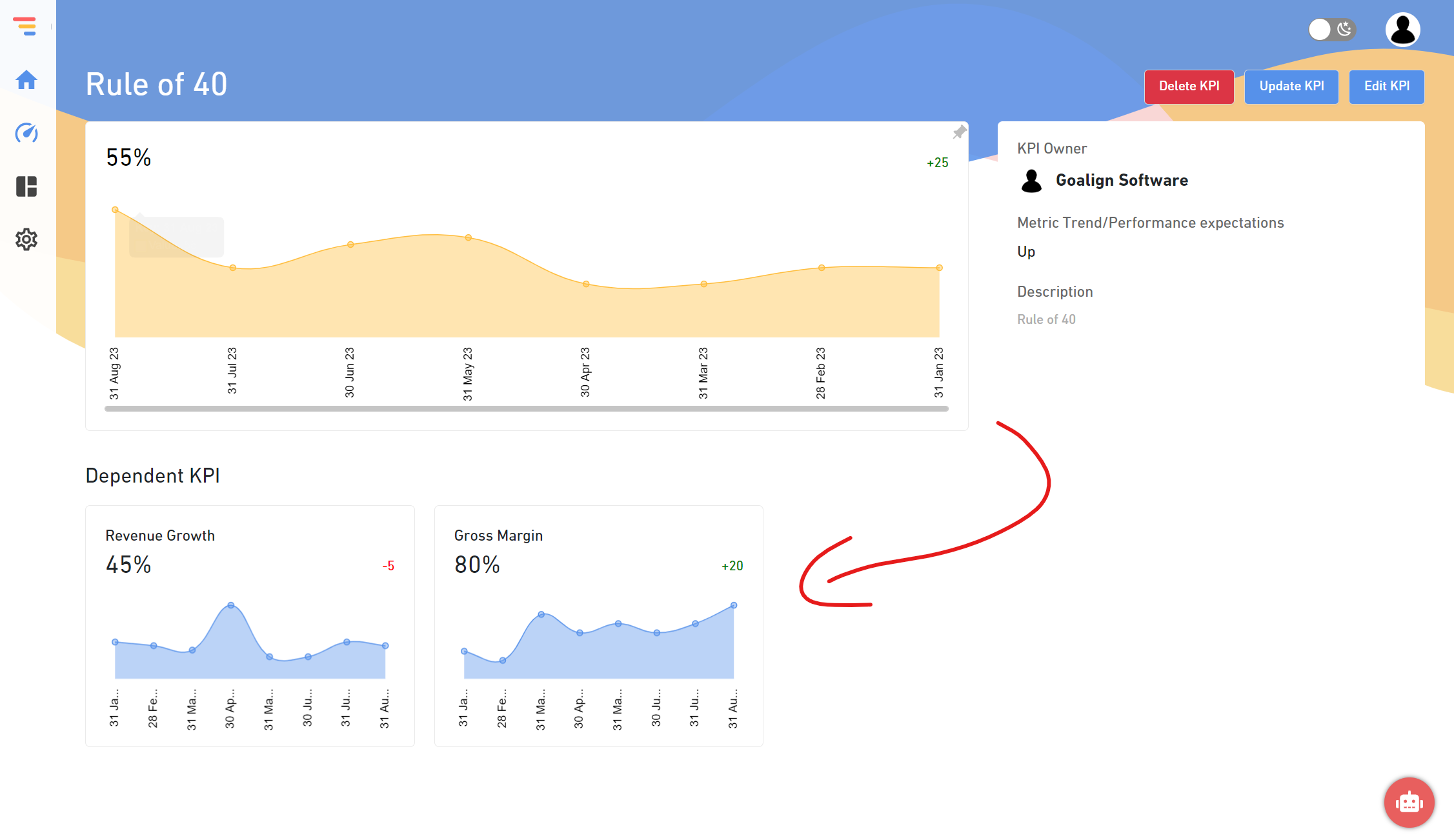SaaS companies want analytics nearly as much as they require their code to function. Employing a dashboard to monitor specific metrics may help you maintain your code running by detecting mistakes and software difficulties and measuring overall user happiness. Without KPIs, you have no method of analyzing your team’s productivity or your firm’s performance.
Software exists to solve problems, automate processes, or otherwise assist users. If any of these features are lost, it becomes outmoded and worthless.
What Are Key Performance Indicators KPI’s in SaaS?
KPIs are performance indicators that help make choices. KPIs may be high-level, such as relative market share, or more actionable and individual, such as the win/loss ratio of a salesperson or team. SaaS organizations, whether B2B or B2C, must use KPIs that demonstrate progress toward whatever will increase their market share and highlight areas that need development.
Calculating lower-level and high-level KPIs may provide employees with a 360-degree view of how their actions influence the firm. Assume your company offers a free version of its software product. A lower-level KPI may be the percentage of users who sample the free version and subsequently subscribe to the premium version. Growth in monthly recurring revenue is a relevant high-level KPI for the firm.
What are the four areas that your KPI’s in SaaS should cover?
Revenue and growth, marketing, sales, and customer success should all be included in your SaaS KPIs. Even if you monitor a few KPIs, be sure to include the following categories as indicators of overall company success:
- Revenue and expansion: Companies, particularly startups, may need help maintaining a consistent income stream and revenue growth. These KPIs serve as an important barometer.
- Marketing: Marketing KPIs reflect how successfully a firm develops an interest in its goods, so that prospective clients are aware of them and recognize their worth.
- Sales: These KPIs describe the success of moving prospective clients through the sales funnel.
- Customer satisfaction: Customer-success KPIs for SaaS reflect how pleased consumers are with the product, demonstrating that it works for them and that your team fixes any problems they may have.
What information should be shown on a SaaS dashboard?
Key performance indicators and other product-specific data should be included in SaaS dashboards. Customer turnover and conversion rate are two variables to consider.
- Customer lifetime value and acquisition cost
- Leads from eligible products
- Annual and monthly income rates
What are KPIs used by SaaS companies?
KPIs that indicate a software problem or client happiness is examined by SaaS companies. Here are a few examples:
- Net promoter rating
- Rate of renewal and retention
- Rate of activation
- Conversion rates and churn
What are the most crucial dashboards for any SaaS?
These five dashboards should always be included in SaaS businesses:
- Dashboard for sales
- Dashboard for revenue and growth
- Dashboard for users
- Dashboard for customer service
- Dashboard for traffic and social media analytics
What exactly are SaaS metrics?
SaaS metrics are key performance indicators used regularly and are especially relevant for SaaS firms. Most of them are concerned with client acquisition, retention, and satisfaction. Here are some examples of SaaS metrics:
- Customer acquisition expense
- Customer life expectancy
- Active users on a daily, weekly, and monthly basis
- Rate of customer retention
- Renewal percentage
What metrics are required for any SaaS KPI dashboard?
1. Churn and conversion rate of customers
These are two of the most critical indicators to monitor in SaaS companies:
Customer churn is the amount of paying customers that ceased using your product over a specific period. To calculate it, divide the number of lost users during a particular period by the total number of users up to that point.
The conversion rate is the number of users who become paying customers after completing a free trial or exposure to a marketing campaign. To determine the conversion rate, divide the number of new paying users over time by the number of trial users or leads.
2. Leads that are product-qualified (PQL)
A PQL is a person or company that discovered value in your product after participating in a free trial or restricted access to your solution. It is comparable to a marketing-qualified lead, but it is more valuable since they choose to test your product. It would help if you continued cultivating those leads and urging them to become paying clients at this level.
To determine which of these consumers is utilizing your product, compare this list to their degree of activity. They’re likely to churn if they’ve been idle most of their trial. That is an excellent time to concentrate on their retention by reaching out, listening to their requirements, and giving assistance.
3. Customer acquisition cost (CAC) and lifetime value of customers (LTV or CLV)
These two indicators are measured individually but should be analyzed jointly. CAC is the money it costs to acquire a new paying customer. That statistic may provide insight into your expenditure, but it becomes more meaningful compared to CLV. LTV is the expected revenue from a consumer throughout their lifetime.
For example, if you earn $8 per user per month, the average account has 10 users, and they utilize your service for two years, you will make $8 per user each month. The LTV is going to be $1920. To be profitable, the CAC rate should be at least three times lower than the LTV. In this case, the most you should spend on purchasing each account is $640.
4. NPS (Net Promoter Score), referrals, or viral coefficient
These are critical metrics to monitor, particularly in early-stage SaaS firms, since they evaluate client success. The Net Promoter Score (NPS) indicates how likely your consumers are to recommend your product to others. It’s generally a value between 0 and 10, with 0 being highly unlikely to suggest and 10 being quite probable.
The number of referrals shows the number of users gained due to a recommendation from one of your existing customers. If this figure is low, consider developing a referral scheme. A viral coefficient may also be used to track referrals. The viral coefficient is the average number of new customers generated by your present consumers.
To calculate the viral coefficient, multiply the number of existing customers by the average referral per customer by the average referral conversion rate and divide by 100.
5. Monthly and yearly recurring revenue (MRR and ARR) (ARR)
The goal of a SaaS company is to solve a market need while simultaneously earning money. These two indicators track revenue:
MRR is the amount of revenue generated by your company month after month. To determine this, divide your monthly account or average user income by the number of monthly active users.
The same principle applies to ARR, except the timescale is a year. Instead of multiplying your monthly account/user average income, divide the yearly figure by the number of active users.
The same techniques may also be used to determine monthly and yearly recurring earnings.
6. Active users on a daily, weekly, or monthly basis
These figures show how many individuals use your software solution daily, weekly, or monthly. Depending on the nature of your service, the time interval may be more or less critical.
For example, if your product is typically viewed daily, three days of inactivity should instantly generate an alarm. However, if you host payroll software typically considered once a week, you should be fine with three-day idleness.
This indicator is also helpful in determining if your retention efforts were successful and if a user became active again after a long time of inactivity.
Conclusion
If you want real-time access to your SaaS business success information, consider purchasing a dashboard solution for your company. This guide will help you learn about all their features and decide which product to buy for your company.






